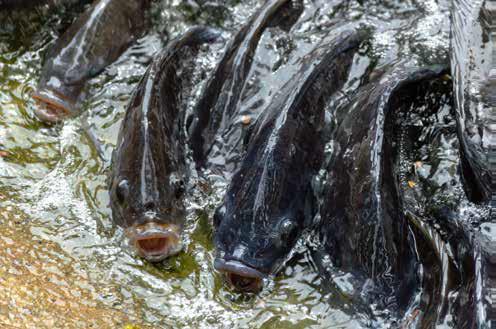Zambia holds 104,8 billion m³ of renewable freshwater, or 4,5% of the total SADC region, making Zambia the country with the fifth-largest supply of renewable freshwater.
This important resource is distributed across numerous major water sources such as the mighty Zambezi, Luangwa, Kafue and Luapula rivers, as well as major lakes like the Bangweulu and dams like Kariba. Couple this with thousands of smaller water bodies, most with excellent temperatures for fish farming, a population of about 17 million people who love to eat fish, a 40% stunted child growth rate and a 50% reliance on fish imports, and you have an attractive lure to practice profitable aquaculture farming in Zambia.
According to the FAO Fisheries Country Profile, fish is an important item in the Zambian diet, accounting for up to 55% of the national dietary animal protein consumption. While commercial aquaculture has developed fish production tremendously in Zambia over the last few years, the gradual stagnation of wild capture output through excessive fishing in natural water bodies has created a supply void. This presents a promising potential for small-scale aquaculture development,
primarily via pond farming. Pond farming with tilapia can be practised in all parts of the country along natural waterways, but also in ponds on dry land, utilising good underground water resources like borehole water, which is available in most parts of the country.
Tilapia have five basic needs to ensure they are healthy and grow as expected:
Clean water
Newly introduced water must be clean enough to drink and be in good supply. Dechlorinate it if
treated with chlorine. Existing water must be maintained through filtration. Treatment of water is
necessary to reduce toxins in the aquatic water. This allows for less frequent water changes.
Oxygen
The oxygen quality and content of the pond is affected by the biomass (all the breathing organisms in your pond including fish and bacteria), water temperature (average 26° C is best), light (sunlight availability in Zambia is adequate), decomposition of mainly fish excreta (produces harmful ammonia) and good surface aeration practices.
Light
Tilapia do not move or eat in darkness. They need bright light, preferably from the sun. Longer periods of light ensure they consume more food and therefore grow faster. This is also true for photosynthesis in plants that need light to help produce beneficial oxygen.
Stocking density
Fish need room to swim. Overpopulation of tilapia in the pond induces stress and results in weaker immune systems. Overpopulation entails that oxygen is consumed faster than it is reintroduced back into the water. (Oxygen is introduced and generated through surface aeration and photosynthesis in living organisms such as phytoplankton and water plants).
Diseases such as Streptococcus, Aeromonas or Columunaris may result from overcrowding.
Feed
Tilapia are omnivores, meaning they enjoy a wide variety of feed. The fingerlings are about 30 grams when placed in the pond. The farmer targets a fish weight of 450 to 600 grams after 6 months.
This requires nutrient-dense manufactured feeds, categorised largely as follows:
- Fish Hatchery: Up to size 3 granules with 44 % crude protein (CP). Feed until fingerlings weigh 10 grams and are about 39 days old.
- Fish Starter: 1,5 mm to 2,0 mm floating pellets with 40% CP. Feed until fish weighs 70 grams and are about 86 days old.
- Fish Grower: 3,0 mm floating pellets with 33% CP. Feed until fish weighs 100 grams and are about 101 days old.
- Fish Finisher: 4,0 mm floating pellets with 30% CP. Feed until fish weigh 450 to 600 grams at about 180 to 226 days old.
How much food to feed your fish is an art to master. It is technical but simple once understood. The main aspects to familiarise yourself with are pond water temperature, the average weight of each tilapia and pond biomass. The latter is more simply ascertained by stocking density per cubic meter of water.
Acquire all the information you need on successful tilapia farming at NamFeeds NMC by contacting Sven at +26(0)21-124-1076 or e-mailsvenp@nmc.co.zm.









